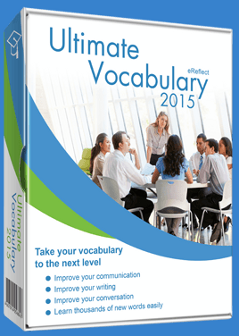Ultimate Vocabulary is an online vocabulary learning and practice program for first graders through adults. You subscribe for a three-year period, and this gives you access for up to five family members on multiple computers. (It probably won’t work on tablets or other devices since you need to use the keyboard and can’t have it blocking part of your screen.) The program comes with 193 lists of vocabulary words, and you can also create your own.
Words lists are extensive with the majority averaging about 100 words per list; there are over 142,647 words in the program’s database. The grade-level lists that are likely to be most appealing to many homeschoolers begin with 26 words in the first of the ten lists for first grade, growing to 42 words on the tenth list for first grade. There are ten lists for each grade level for first through tenth grades, with the number of words per list gradually increasing.
Students preparing for the SAT (11th grade) can use the ten SAT study lists with about 100 words per list. Lists are included for a number of other purposes: GRE Exam (both Masters level and Ph.D. level) TOEFL Exam (advanced ESL words), GMAT exam (ten lists each for essential and supplementary words). On an easier level that is most likely appropriate for ESL students, there are lists of Most Common English Words and English Conversation Words. You could spend years working through all of these lists! If that’s not enough, you can also create your own word lists, storing them in the Cloud so that they are accessible anywhere.
The number of activities available for studying each group of words and the huge number of word lists are what sets this program apart from others.
Students have an option to simply study words in an activity that is similar to reading through dictionary entries with “Word Discover.” Word Discover defines words one at a time with various nuances of meaning and usage. Since there are no games or activities with this section, it is likely to be used only by diligent students who want to dig deeper into word meanings. While various meanings of each word are taught here, the other activities on the site all use a single definition for each word.
Most students will gravitate immediately toward the “Activities and Games” section which has three categories of activities: “Master Words,” “Cool Games,” and “Vocab Quizzes.”
Under “Master Words,” five activities help students master the words and their meanings. “Flash cards” can be flipped quickly to help students review words, their definitions, and their part of speech. “Quick Train” presents a definition followed by two different words from which the student chooses the word that matches the definition. While many of these are very obvious, it still reinforces the definition in the student’s mind. “Vocab Match” presents a matching exercise with six words and definitions. The program remixes words from the group of words selected by the student each time the student plays, but words and definitions repeat from time to time.” Vocab Memory” is played like memory card games, but matching words with their definitions rather than two identical items. Blue word cards and green definition cards are randomly mixed, making it needlessly difficult to play in my opinion. “Crazy Clues” should be played only after a student has worked with a word list enough to be very familiar with the words. Students need to fill in selected letters to create vocabulary words. They can use the hints (definitions) or not.
“Cool Games” has four games: Unscramble, Crossword, Word Finder, and Hangman. The games all offer variations of their namesakes, with Crossword being the least like a standard version of the game. (It fills in multiple letters for you both at the beginning and as you play.) Games reinforce learning. You should think of them as learning activities rather than fun. The entire program is businesslike rather than colorful and game like.
Under “Vocab Quizzes,” you can select Word Recall, Meaning Recall, Spelling Drill, and Power Recall. As with “Crazy Clues,” Power Recall should be reserved until students are very familiar with a particular list of words.
Students must choose activities each time. The program does not have a preset sequence they must follow. However, it does track student progress and shows levels of success.
In addition to online study options, there are also printable worksheets with three choices. You can print out flash cards, vocabulary worksheets, or spelling worksheets. (There are no answer keys for the worksheets, but students should be able to figure out answers themselves. Students can use the program’s dictionary online if they need it. Audio pronunciations are available as well.
Since Ultimate Vocabulary targets both children and adults, there are no separate teacher and student logins. Students can access everything. This doesn’t present a problem. The program is set up for independent study with instructions readily available as needed.
While it has word lists for younger students, it is likely to be more useful with older students. Sometimes the definitions of words for younger students include words with which they might not be familiar, and I suspect some of the activities might be frustrating for young students as well. I think that fourth or fifth grade would be an ideal point at which to begin using the program. It should be great for high school students as well as for older students needing to brush up vocabulary skills for graduate-level exams and for adults who just want to develop a stronger vocabulary.







